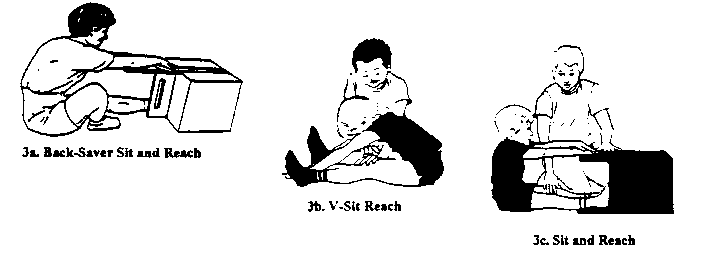
page 4
Maintaining adequate joint flexibility is important to functional health. Decreased flexibility is generally not a significant health problem for young people. However, students need to understand the importance of maintaining flexibility and range of motion as they age.
Objective: To measure hamstring flexibility by reaching as far as possible on the right and left sides of the body.
Equipment: This assessment requires a sturdy box approximately 12-inches high (four- fold mats may be stacked to 12-inches in lieu of "the box"), measuring scale (yardstick/tape measure).
Set-Up: The measuring scale is placed on top of the box (mats) with the 9-inch mark even with the near edge of the box. The "zero" end of the ruler is nearest the student.
Testing: The student removes his/her shoes and sits down in front of the test apparatus. One leg is fully extended with the foot flat against the end of the box. The other knee is bent with the sole of the foot flat on the floor and 2 to 3 inches to the side of the straight knee. The arms are extended forward over the measuring scale with the hands placed one on top of the other. With palms down, the student reaches directly forward with both hands along the scale four times and holds the position of the fourth reach for at least 1 second. After measuring one side, the student reverses the position of the legs and reaches again.
Rules: The bent knee may move slightly to the side as the body moves by it.
Scoring: Record the highest number of inches reached (either side of the body) to the last whole inch.
Objective: To measure flexibility of lower back and hamstrings by reaching forward in the V position.
Equipment: A clean surface, measuring scale (yardstick and/or tape measure).
Set-Up: A straight line, two-feet long, is marked on the floor as the baseline. A measuring line is drawn perpendicular to the midpoint of the baseline extending two feet on each side and marked off in half-inches. The point where the baseline and measuring line intersect is the "0" point.
Testing: The student removes shoes and sits on floor with measuring line between legs and soles of feet placed immediately behind baseline, heels 8-12 inches apart. Student clasps thumbs so that hands are together, palms down, and places them on measuring line. With the legs held flat by~a partner, student slowly reaches forward as far as possible, keeping feet on baseline and flexed. After three practice tries, the student holds the fourth reach for three seconds while the distance reached is recorded.
Rules: Legs must remain straight with soles of feet held perpendicular to the floor (feet flexed). Students should be encouraged to reach slowly rather than "bounce" while stretching.
Scoring: The score is recorded to the nearest half~inch, and is read as plus scores for reaches beyond baseline, minus scores for reaches behind baseline.
Objective: To measure flexibility of lower back and hamstrings by reaching as far as possible with the fingertips.
Equipment: This assessment requires a sturdy box approximately 12-inches high (four-fold mats may be stacked to 12-inches in lieu of "the box"). A measuring scale (meter stick) is placed on top of the box with 23 centimeters at the level of the feet.
Testing: Student removes shoes and sits on floor with knees fully extended, feet shoulder-width apart and soles of the feet held flat against the end of the box (mats). With hands on top of each other, palms down, and legs held flat, student reaches along the measuring line as far as possible. After three practice reaches, the fourth reach is held while the distance is recorded.
Rules: Legs must remain straight, soles of feet against box, and fingertips of both hands should reach evenly along measuring line.
Scoring: Scores are recorded to the nearest centimeter.